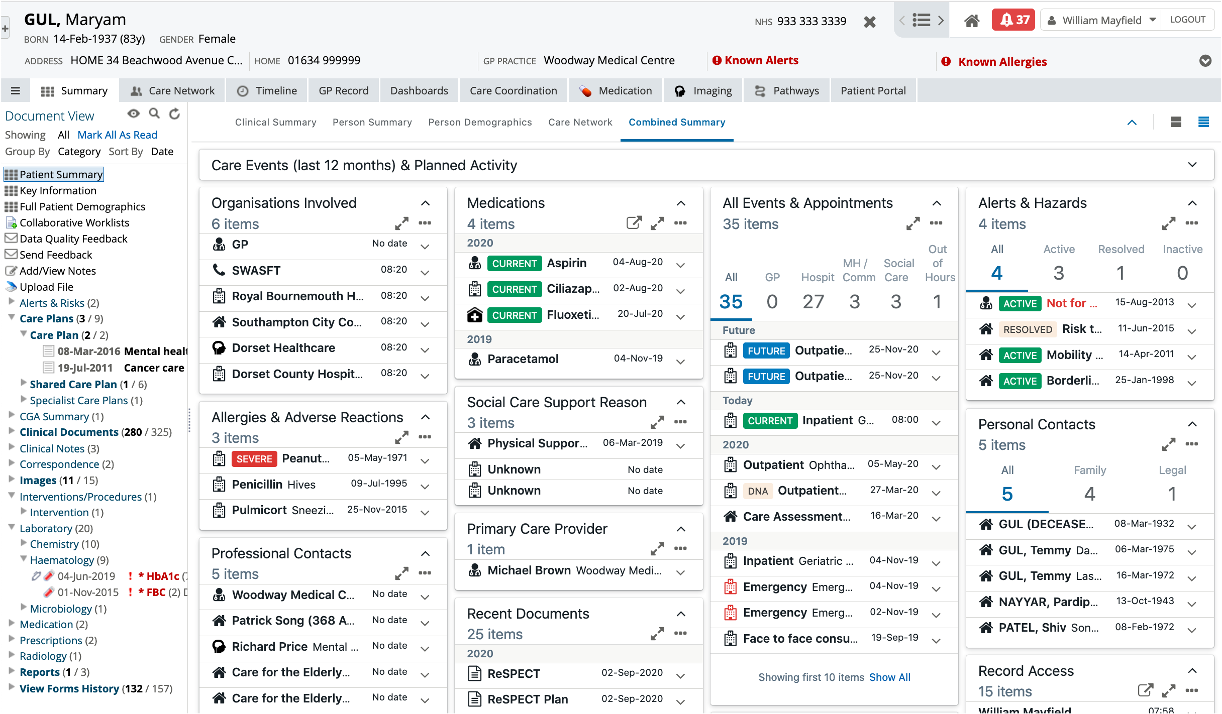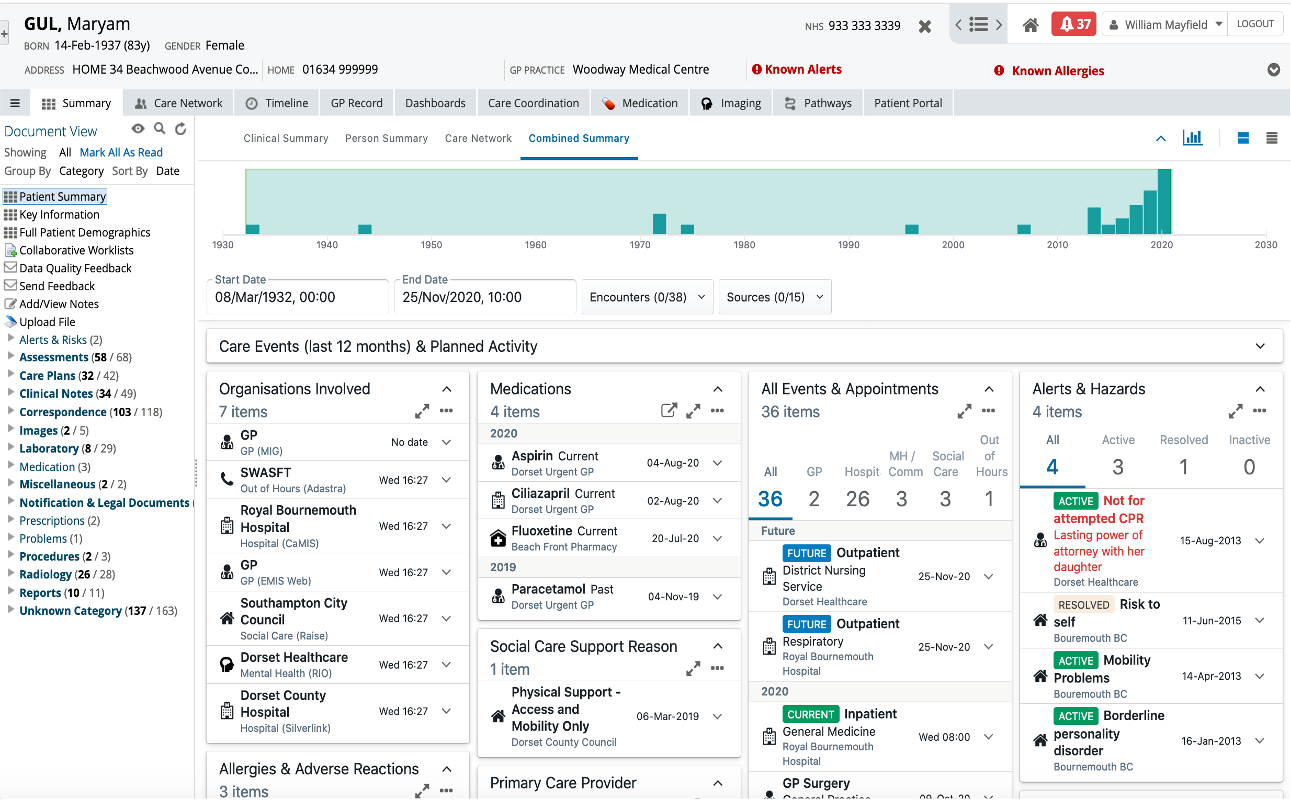Amadeus is Orion Health’s platform for shared care records, population health management, and precision medicine. As Ben Wilson, product specialist lead, told the fourth in the autumn series of UK and Ireland customer webinars, “it is core to what we do.”
Amadeus has the capability to ingest data from any organisation and make it available, where appropriate, to health and care professionals through the Orion Health Clinical Portal. This data can also flow through to other solutions including Coordinate, Virtual Care and Medicines, and to an increasingly sophisticated suite of analytics and machine learning tools. So, what’s new?
Clinical Portal Dashboards
The biggest change for users of the Clinical Portal is the arrival of Dashboards. Wilson explained: “This is our new user interface for the Clinical Portal enabled by responsive web technology. It enables more information to be easily accessible and easier to find and navigate through.”

Because Clinical Portal Dashboards uses a responsive display, it is also “enabling our initial move to using shared care records on mobile devices, via a progressive web app.” Core to portal dashboards is the idea of ‘panel types’ that enable types of information, such as diagnoses or medications, to be grouped together.
The new dashboard panels replace the traditional ‘windowlet’ views and can be expanded or contracted by the user to show more or less information. Iconography and colours are used to show where the information comes from and to draw the user’s attention to important information such as known allergies or current medications.
Visualise the data over time
Information in the Clinical Portal can also be represented as a chronological distribution of data in a timeline view and an interactive filter makes it easy for the user to drill into the information they are looking for. This means, for example, that users can interrogate the timeline to find out how a patient’s treatment or medications have changed around an event like a hospital discharge.

Case study: Connecting Care is one of the longest-established and most mature shared care records in the UK. Over time, it has expanded from a project to share a small number of data items between care providers into an integrated digital care record that supports the care delivered by 23 health and care organisations for more than 1 million people in Bristol, North Somerset and South Gloucestershire.
Connecting Care has been an early adopter for Clinical Portal Dashboards. Wilson explained that reaction from front line professionals has been very positive. “Comments include: ‘It is more user-friendly and visually easier to decipher’ and ‘Filtering makes it easy to find things’,” he told the webinar.
Top tips: Moving from the Clinical Portal’s traditional layout to dashboards takes planning, and Wilson gave organisations that are thinking of making the change some tips. “If you are interested in the dashboards, we do recommend an impact assessment is the first thing to be done,” he said.
“Dashboards does require the latest version of the Clinical Portal, 8.10 or later, and there are some other dependencies. So, the impact assessment seeks to understand what is deployed currently and what will need to be upgraded.”
Mobile
Chris Lucas, vice president interoperability and clinical portals, took over the webinar to explain how the concepts behind Clinical Portal Dashboards are enabling Orion Health to develop mobile capability and to “provide the same kind of view as you have on the desktop on a mobile phone.”
The progressive web app provides a subset of the information available through the full portal, focused on carrying out specific tasks, such as bedside observations. Or, as Lucas put it, “everything you need to capture and use information on the go” and to put Clinical Portal functionality “in the user’s pocket.”
Clinical Portal 8.11
The next release of the Orion Health Clinical Portal will make the most of these developments. Ben Wilson said two exciting features will be ‘docked windows’ and the start of ‘personalisation’. Users will be able to dock or fix a piece of information into an area of their screen, so they can see the information it contains alongside other data in the portal.
For example, Wilson suggested, clinicians might choose to dock medications information so they can view it alongside test results, or Care Pathways users might dock information that they need to put into a Care Pathways form.
The first element of personalisation, meanwhile, will see the system ‘remember’ any changes that a user makes to the width of the Clinical Document Viewer (CDV) Tree. In the future, this idea will be extended to other settings.
Regional priorities
Orion Health is also looking to develop some features of the Clinical Portal that are particular priorities for UK customers. These include single sign-ons so that users of acute, community and primary care systems can access shared care records without logging out of their main business system and into the Integrated Digital Care Record (IDCR).
Wilson said there has been lots of progress in this area, with Servelec now on board alongside EMIS, InPS, TPP, Adastra, IBIS, Fortrus, Lorenzo, and BadgerNET. Further regional developments include a recent documents card, which enables users to easily find and launch forms, letters and other documents, and a move towards structured data. Structured data will make it easier for users to see information from different organisations alongside each other, which Wilson argued would “add value” for clinicians by creating “a true patient summary” while “improving the clinical safety of the system,” by for example flagging that a patient has known allergies in the patient banner. Wilson said both Medical Information Gateway (MIG) and NHS GP Connect were being focussed on for this work.
As a company committed to open standards, Orion Health is also working to incorporate recent Professional Record Standards Body standards for naming documents, transfer of care, information for care home staff, and ‘About Me’ into the Clinical Portal; while its roadmap is all about using Fast Healthcare Interoperability Resources (FHIR) capabilities to integrate it with more systems.



